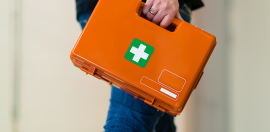Media’s Powerful Role in Ending Violence Against Women
15 September 2016 at 4:59 pm
The media has a powerful role in exposing violence against women, shaping national conversation and shifting policy, according to Not for Profit Our Watch.
The organisation, which aims to change the culture, behaviour and power imbalance that leads to violence against women, held its annual media awards on Wednesday evening.
Our Watch CEO Mary Barry told Pro Bono Australia News, journalists who report on the issue have a great deal of responsibility.
“It’s very important for us to recognise and reward excellence in reporting on violence against women, and particularly reports that focus on the whole issue, that talk about the causes of the issues, why we have violence against women, and what we need to do to prevent it,” Barry said.
“By the media portraying violence against women in a different way, going past the statistics, and really looking at the drivers… it’s certainly going to influence policy, it’s going to influence behaviour and it’s going to influence how we see violence against women.
“The media are a very, very powerful player in really getting this message across and leading that conversation.”
Journalists Lauren Novak and Sheradyn Holderhead, from Adelaide’s Sunday Mail and The Advertiser, took out the top honour for their series, Knowing What We’re Up Against.
The judges commended the clear objective of their media campaign – “to know the extent of the issue of family violence so as to stop it”.
Over a series of articles the pair revealed previously unknown data on the extent of family violence in South Australia.
Police were called to 18,665 domestic violence incidents in one year alone, and more than 6,000 aggravated assaults reported each year relate to domestic violence.
“All of [the stories] had the same kind of theme of getting out information that we previously hadn’t seen – mostly figures – with the idea of… how do you tackle a problem if you can’t first quantify it,” Novak told Pro Bono Australia News.
“And data has been notoriously difficult to get in South Australia on how big the problem is here. It’s been really hard to get figures on how many domestic violence assaults there have been or how many deaths there had been, which were some of the things that we wrote about.
“In order to get that information we, at various times, went through parliamentary committees… we submitted questions to the police and government, we tried freedom of information requests.
“We also just lobbied, so we would constantly be ringing ministers’ offices, the police media unit to try to get them to tell us why they couldn’t give us this information.
“It was more effort than it should take, it really should not be that difficult to get the data that we eventually got.”
But Novak and Holderhead’s efforts made a tangible difference.
“After months and months of trying to get information out of the police and government about how many women and children had died in South Australia we ended up just publishing a story which said authorities can’t tell us that number,” Novak said.
“The very next day the police commissioner went on radio and held a press conference and gave the figures – just like that.
“We were pretty proud that we got the figures out of authorities, but we were really frustrated that it took that long for information that South Australians have a right to know. And, if they do know, it helps them to understand the scope of the problem.”
Novak said, generally, that the media had become “more conscious” about reporting on the issue, and had even moved beyond just focusing on the problem.
“Now we’re starting to get to a point where we can be writing about… ways to approach the problem, so talking about where funding should be directed and where there are loopholes in the system that are leaving people exposed,” she said.
“And also to put pressure on authorities, if there’s no public discussion about something it’s very easy for government to ignore it.
“Sadly I think we see that with the mental health debate, which runs parallel at some points to domestic violence. Certainly in South Australia there’s probably not as much focus on that and therefore there’s less pressure on the government to do something about it.
“Whereas we’ve seen the pressure on the government about domestic violence has prompted them to do something and to fastrack what they were already doing.”
Barry also said the 140-odd “very high-quality” submissions to their media awards showed how much progress had been made.
“We’re starting to find there’s more context around stories. It’s not just focusing on the fact a woman has been killed, it’s focusing on why we have domestic violence, what can lead to these circumstances and what’s driving violence against women,” she said.
“It’s also highlighting some of the common behaviours and the norms and practices in our culture that can lead to violence against women, and it’s also addressing things like sexism, misogyny… and just trying to make the link for the community between that kind of behaviour and violence against women.
“And this is the first time that this has really been occurring.”
But she said there was still work to be done, based on a study conducted last year with ANROWS, the Not for Profit responsible for researching violence against women.
“Only one in five articles include explicit information to help the reader to understand the broader issue, including why the violence occurs, the statistics on prevalence or warning signs of violence,” she said.
“Victim blaming or excuses for the perpetrator appeared in around one in six articles, and male perpetrators of violence were rendered largely invisible in more than half of the media reports on the issue, and less than 5 per cent of media items include information for women on where to seek help.
“These are still some of the challenges that we will be addressing.”
If you or someone you know is impacted by sexual assault, family violence or domestic violence, call 1800RESPECT on 1800 737 732 or visit 1800RESPECT.org.au









